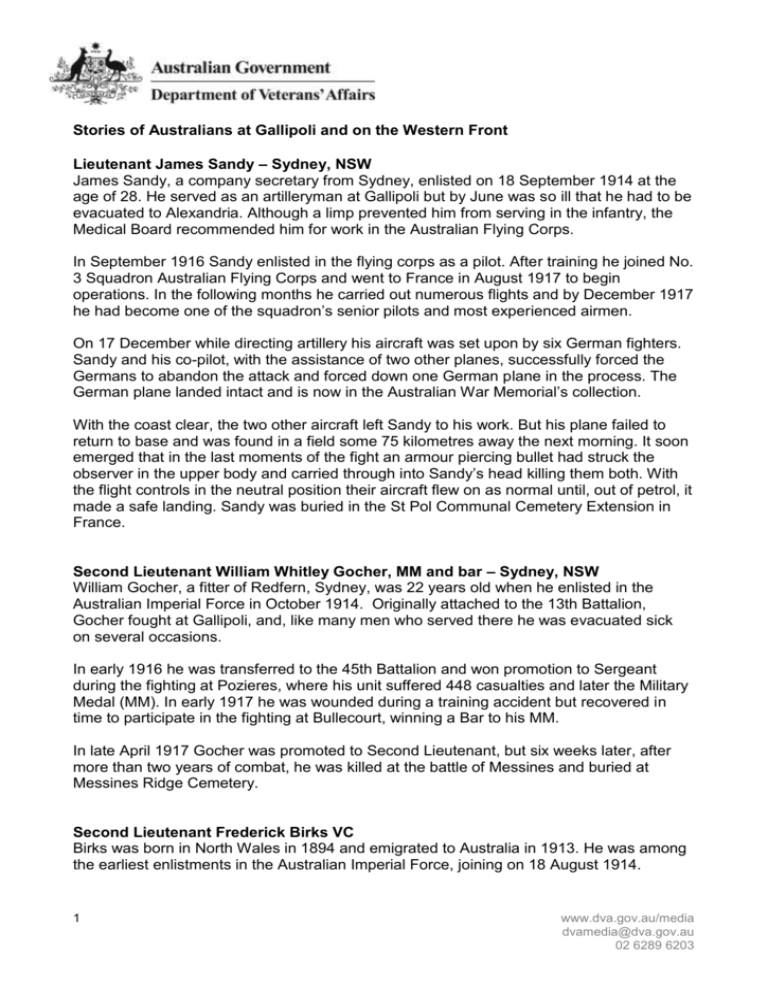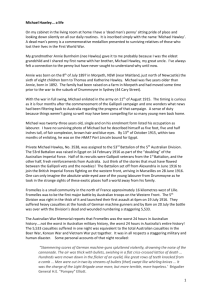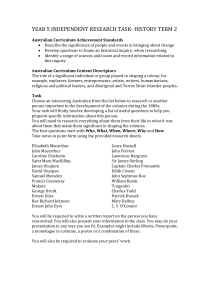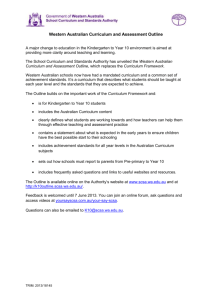Major General Sir William Holmes – Sydney, NSW
advertisement

Stories of Australians at Gallipoli and on the Western Front Lieutenant James Sandy – Sydney, NSW James Sandy, a company secretary from Sydney, enlisted on 18 September 1914 at the age of 28. He served as an artilleryman at Gallipoli but by June was so ill that he had to be evacuated to Alexandria. Although a limp prevented him from serving in the infantry, the Medical Board recommended him for work in the Australian Flying Corps. In September 1916 Sandy enlisted in the flying corps as a pilot. After training he joined No. 3 Squadron Australian Flying Corps and went to France in August 1917 to begin operations. In the following months he carried out numerous flights and by December 1917 he had become one of the squadron’s senior pilots and most experienced airmen. On 17 December while directing artillery his aircraft was set upon by six German fighters. Sandy and his co-pilot, with the assistance of two other planes, successfully forced the Germans to abandon the attack and forced down one German plane in the process. The German plane landed intact and is now in the Australian War Memorial’s collection. With the coast clear, the two other aircraft left Sandy to his work. But his plane failed to return to base and was found in a field some 75 kilometres away the next morning. It soon emerged that in the last moments of the fight an armour piercing bullet had struck the observer in the upper body and carried through into Sandy’s head killing them both. With the flight controls in the neutral position their aircraft flew on as normal until, out of petrol, it made a safe landing. Sandy was buried in the St Pol Communal Cemetery Extension in France. Second Lieutenant William Whitley Gocher, MM and bar – Sydney, NSW William Gocher, a fitter of Redfern, Sydney, was 22 years old when he enlisted in the Australian Imperial Force in October 1914. Originally attached to the 13th Battalion, Gocher fought at Gallipoli, and, like many men who served there he was evacuated sick on several occasions. In early 1916 he was transferred to the 45th Battalion and won promotion to Sergeant during the fighting at Pozieres, where his unit suffered 448 casualties and later the Military Medal (MM). In early 1917 he was wounded during a training accident but recovered in time to participate in the fighting at Bullecourt, winning a Bar to his MM. In late April 1917 Gocher was promoted to Second Lieutenant, but six weeks later, after more than two years of combat, he was killed at the battle of Messines and buried at Messines Ridge Cemetery. Second Lieutenant Frederick Birks VC Birks was born in North Wales in 1894 and emigrated to Australia in 1913. He was among the earliest enlistments in the Australian Imperial Force, joining on 18 August 1914. 1 www.dva.gov.au/media dvamedia@dva.gov.au 02 6289 6203 He served with the 2nd Field Ambulance on Gallipoli, where he was wounded, though not badly enough to require evacuation. Having been promoted to Lance Corporal in France in April 1916, Birks was awarded the Military Medal for “consistent good services” as a stretcher bearer at Pozieres. He received a commission in April 1917 and was transferred to the 6th Battalion the following month. On 20 September 1917 Birks led his platoon in an attack on a German strong point at Glencourse Wood during the battle for Menin Road, his first major engagement as an infantry officer. Accompanied only by a Corporal, Birks rushed the strong point and captured a machine gun, killing 10 of its 25 defenders. He then organised his platoon and men from other units to hold the ground he had won. For this action he was posthumously awarded the Victoria Cross for ‘conspicuous bravery’ as the next day, while helping to dig out men who had been buried by shellfire, Birks was himself killed by a German shell. He was buried in China Wall Cemetery, Zillebeke. His Victoria Cross is on display at the Australian War Memorial. Major General Sir William Holmes – Sydney, NSW Born in Sydney in 1862 William Holmes was discouraged from joining the military by his father who believed that the public service offered a more secure career. Nevertheless Holmes joined the New South Wales Military Forces as a bugler at the age of 10 and rose to command the regiment in 1903. His military career ran in parallel to his government work and he accepted a demotion to serve in the South African War with the New South Wales Infantry. Holmes was wounded in South Africa and on his return to Australia resumed his public service work while also continuing voluntary military service. When the First World War broke out Holmes led an Australian expeditionary force to occupy German possessions in New Guinea and the Pacific. In 1915 he served at Gallipoli and in 1916 led the 5th Australian Brigade on the Western Front. He was promoted to Major General and given command of the 4th Australian Division in January 1917. He led the division at Messines but was killed by a German shell on 2 July 1917 while accompanying the Premier of New South Wales around the Messines (Mesen) battlefield. He is buried at Trois-Arbres Cemetery, Steenwerck in Belgium. Lieutenant Charles William Stoerkel William Stoerkel was born in London but grew up in South Australia, where he became a farmer. He enlisted in the Australian Imperial Force on 11 September 1914, shortly after his 19th birthday. When he embarked for Egypt with the 16th Battalion, Stoerkel was a Lance Corporal. He fought on Gallipoli, serving for a time as a guardsman to Sir Ian Hamilton, commander of the Mediterranean Expeditionary Force. In March 1916 Stoerkel was transferred to the 48th Battalion and sent to the Western Front. He suffered the first of his three wounds in August 1916 at Pozières and was promoted to Second Lieutenant the following month. 2 www.dva.gov.au/media dvamedia@dva.gov.au 02 6289 6203 Having been mentioned in Sir Douglas Haig’s despatch, for devotion to duty and bravery in the field, Stoerkel was promoted to Lieutenant in February 1917. He was wounded in the face at Messines and shortly afterwards was awarded the Military Cross (MC). Stoerkel served in the infantry for the remainder of the war, winning a Bar to his MC in May 1918. He went on to marry an English girl in 1919 and returned to Australia later that year. He died in November 1985. Captain Albert Jacka VC – Geelong, Victoria Albert Jacka was born near Geelong in Victoria on 10 January 1893. At the age of 18 he got a job with the Victorian State Forests Department but left to join the Australian Imperial Force (AIF) when war broke out. He was the first member of the AIF to win the Victoria Cross, during the fighting at Gallipoli. He also won promotion at Gallipoli, leaving the peninsula as a Company Sergeant-Major. By the second half of 1917 Jacka had risen to the rank of Captain and been decorated several more times. He won the Military Cross at Pozieres and a Bar to that award at Bullecourt. His military career ended when Jacka was gassed in late May 1918. Back in Australia he established a merchandise and importing business, but success eluded him. He became mayor of the local council at St Kilda in Melbourne but his health deteriorated during the depression. He died in January 1932 and was buried with full military honours. Major Percy Black – Beremboke, Victoria Percy Black was born 1877 and went on to become a carpenter before heading to the West Australian goldfields. He was mining at Mount Jackson when war broke out. Black enlisted as a Private in the 16th Battalion, Australian Imperial Force, on 13 September 1914 and sailed for Egypt in December. He first saw action at the Gallipoli landing on 25 April 1915 when his unit took over the Pope's Hill zone. For his bravery at Gully Ridge, he received the Distinguished Conduct Medal and five days later was commissioned Second Lieutenant in the field. He was mentioned in dispatches on 5 August, promoted temporary Captain four days later, and remained at Gallipoli until the evacuation. Black was promoted to Major on 27 April 1916. His unit was posted to the Western Front in June and suffered severe casualties in the battle of Pozières. On 28 August it returned to the front line and two days later Black's 'B' Company was detailed to capture Mouquet Farm. In the attack Black immobilized a machine-gun, killing the gunner, before being wounded in the neck and evacuated. He was later awarded the Distinguish Service Order and the French Croix de Guerre for his actions. 3 www.dva.gov.au/media dvamedia@dva.gov.au 02 6289 6203 His next engagement was the first battle of Bullecourt on 11 April 1917. Black, commanding the battalion's right flank, led his men through a 'hurricane fusillade', captured the first trenches and pressed on towards the support-line, but was then shot through the head; he was one of 640 casualties in the 16th Battalion that day. His comrade Harry Murray searched for his body; however, Black has no known grave and his name is commemorated on the Australian National Memorial at Villers-Bretonneux, France. Australia’s official war correspondent Charles Bean once described him as the greatest fighting soldier in the Australian Imperial Force. Lieutenant Colonel Henry (Harry) Murray VC – Launceston, Tasmania Henry (Harry) Murray was born in 1880 at Evandale, Tasmania. Harry served in the Australian Field Artillery (militia) in Launceston for six years before enlisting as a Private in the Australian Imperial Force on 13 October 1914. He landed at Gallipoli on 25 April 1915 with his mate Lance Corporal Percy Black as one of the 16th Battalion's two machine-gun crews. Murray was wounded several times, was promoted to Lance Corporal on 13 May and won the Distinguished Conduct Medal for his bravery in fighting between 9-31 May. He spent June in hospital and was wounded again on 8 July. A month later he received a remarkable series of promotions. On 13 August he was made a Sergeant, commissioned as a Second Lieutenant and transferred to the 13th Battalion. By 1 March 1916 Murray had reached the rank of Captain and soon after sailed for France. On the Western Front Murray defied the statistics, participating in each of his unit's major actions and surviving. He received the Distinguished Service Order (DSO) for his role in the fighting at Mouquet Farm, where he was twice wounded, keeping him from the front until October. Four months later, on the night of 4-5 February 1917, Murray led his company's attack on Stormy Trench, near Gueudecourt. Over almost 24 hours they repelled counter-attacks, fought in merciless close quarter battles and suffered under intense shell-fire. Some 230 members of the Battalion were killed in the fight and Murray was awarded the Victoria Cross. In April 1917, in the 1st battle of Bullecourt, Murray's unit, following the 16th Battalion, saw them caught against the wire in a torrent of machine-gun fire. The gallant Percy Black was killed trying to find a gap in the wire. Murray got through to the German trenches however, the artillery was not permitted to fire and under a heavy German barrage Murray withdrew his men. For his part in the battle he received a Bar to his DSO. On 11 April, the day of the battle, he was promoted temporary Major and towards the end of the year he temporarily commanded his battalion. In March 1918 he was promoted to Lieutenant Colonel and given command of the 4th machine gun battalion. He remained in this position until the end of the war. In October 4 www.dva.gov.au/media dvamedia@dva.gov.au 02 6289 6203 1918 Murray was awarded the French Croix de Guerre and in May 1919 was awarded a CMG. His Australian Imperial Force appointment ended on 9 March 1920 and after discharge in Tasmania he moved to Queensland to become a grazier. He married in 1921 but separated in 1925 and then moved to New Zealand. He married Ellen Cameron in 1927 and they returned to Queensland. In 1928 he bought a property in Richmond where he lived for the rest of his life. Murray enlisted for service during the Second World War and commanded the 26th Battalion in north Queensland until August 1942. He retired from the army in early 1944. Australia’s official war correspondent Charles Bean described him as the most distinguished fighting officer of the Australian Imperial Force. Murray died of a heart attack following a car accident on 7 January 1966. Sergeant John (Jack) White – Gippsland, Victoria John White was born in Gippsland in 1888 and went on to work as a blacksmith before enlisting in the Australian Imperial Force on 11 February 1916. He was posted to the 22nd Battalion which served on Gallipoli from September 1915 until the evacuation. White joined the battalion in France in September 1916 after it had been through the terrible fighting at Pozieres earlier in the year. In December 1916 he received the first of a series of acting and later permanent promotions, reaching the rank of Sergeant in March 1917. His battalion was involved in the Bullecourt fighting and he was killed there on 3 May 1917. No trace of his body was found at the time but his family received a small number of his effects in 1918. Listed as ‘missing presumed killed’, White’s name was engraved on the wall of the Australian National Memorial at Villers-Bretonneux. More than seven decades later, in 1994, a local uncovered his remains close to the ‘Digger’ Memorial at Bullecourt. He was given a military funeral on 11 October 1995 which was attended by dignitaries, an honour guard and local residents. He was buried at Queant Road Cemetery. Among those in attendance at his funeral was his daughter, Myrle who was a young child when Jack enlisted. Lieutenant Tom Richards – Emmaville, NSW Tom Richards was born in 1882 in Emmaville, NSW and went on to become a rugby international representing Australia at the London Olympics in 1908 and taking home a gold medal. He enlisted in the Australian Imperial Force in August 1914 at the age of 31 and landed at Gallipoli on the morning of 25 April 1915 with the 1st Field Ambulance, serving as a stretcher bearer during the campaign. In 1916 he went to the Western Front and 5 www.dva.gov.au/media dvamedia@dva.gov.au 02 6289 6203 transferred into the 1st Infantry Battalion in December. He was promoted to Second Lieutenant having risen steadily through the non-commissioned ranks. Richards fought at Bullecourt which he described in his diary as ‘the gaping jaws of hell.’ Writing later he described the scene when Australian soldiers fled in terror having, for the first time, come under attack by German flame throwers. Richards helped steady some of the panicked men and continued to defend his position. In August 1917 he was awarded the Military Cross in fighting near Bullecourt. He was evacuated to England twice in 1917 and again in May 1918, with his back and shoulders damaged by a bomb blast. He was repatriated to Australia in June 1918 after almost four years of service. He lived in Sydney during the post-war years, married and had two children before separating from his wife. In 1935, with worsening health he moved to Brisbane where he died of tuberculosis on 25 September that year. In 2001 the trophy for Rugby Tests between Australia, the British and Irish Lions was named the Tom Richards Cup to honour the only player to have represented both sides. Images Please note images of all servicemen (excluding Sergeant White) are available at on the Australian War Memorial website. Email DVA Media for access. 6 www.dva.gov.au/media dvamedia@dva.gov.au 02 6289 6203







